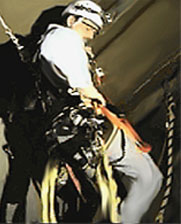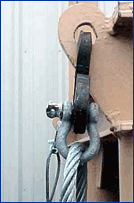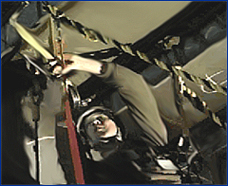Shipyard Employment eTool
Hanging Staging (Marine) >> Installation/Disassembly: Fall Protection SWP 2. Implement Precautions for Cable Hangers or "Rope Walkers"
Installation/Disassembly: Fall Protection
SWP 2. Implement Precautions for Cable Hangers or "Rope Walkers"
The Need for Rope Walking

Rope walking is a method used for attaching suspension cable assemblies to overhead points.
Photo courtesy of OSHA.
One operation involved in the installation/disassembly of marine hanging staging that cannot be carried out on the ground is the attachment of suspension cable assemblies to overhead structural supports.
Further, in certain vessels, the use of ladders, mechanized lifts, and other ground-based equipment to reach certain attachment points on the overhead is impractical or poses a greater hazard. Thus, to accomplish this operation, the shipyard industry uses a method of working aloft known as "rope walking."
The Rope Walking Procedure
Rope walking is physically demanding work. Protected with a full-body harness and a self-retracting lanyard/lifeline (SRL) secured to an anchorage near the point of access, a cable hanger or rope walker moves from point to point across an overhead area. As the rope walker travels, hanging and standing on "footholds" or stirrups attached to weep holes (also known as "rat holes") or other openings on the overhead, the rope walker connects a succession of stand-off pulleys that maintain downward tension on the lifeline and prevent a swing fall.

Attachment point.
Photo courtesy of VSRA.
Using safety hooks, the stirrups are attached to the same kinds of openings in the overhead supports that ultimately accommodate the attachments for the scaffold's suspension cable assemblies. In moving from location to location, the rope walker hoists the suspension cable assemblies from the base of the tank and attaches them to overhead supports with S-hooks, pork chops, or beam clamps.
The procedure is similar whether the rope walker is involved in installing or dismantling a hanging scaffold.
Video clips of rope walking activity. These video segments were filmed by OSHA at Newport News Shipbuilding in Virginia with the assistance of the Virginia Ship Repair Association, Inc. (VSRA).
To view the videos on a computer you will need to have Windows Media Player or equivalent. The videos have been optimized for connection speeds of 150 Kbps or greater. If your connection is less than 150 Kbps you may experience difficulties.
Note: The videos clips below do not contain audio.
- Rope walker suiting up with gear and PPE (WMV*, 2 MB, 1:54 seconds) >>
- Rope walker installing cable hangers (WMV*, 3 MB, 2:47 seconds) >>
- Rope walker retrieving cable hangers (WMV*, 2 MB, 2:14 seconds) >>
Definition
-
What is a safety hook?
More information
-
View and/or print Illustration 1 of a safety hook for use in rope walking.
-
View and/or print Illustration 2 of a safety hook for use in rope walking

Rope walking is physically demanding and specialized work and it requires fall protection at all times.
Photo courtesy of OSHA.
- Rope walkers must have 100% fall protection at all times.
- Employers should assign the task of rope walking only to workers with the physical endurance and upper body strength necessary for this kind of activity.
- Before assigning workers to the task of rope walking, employers should evaluate their capacity for such work by testing them at ground level to determine their familiarity with the procedures for rigging, fall protection, and retrieval.
- Rope walkers must be trained to understand the specialized rigging and fall protection procedures established by their employers, and to identify and use only those supporting structures that are strong enough for the intended loads. (See also Job Hazard Analysis.)
- Equipment used by rope walkers (such as full body harness, carabiners, and stirrups) must comply with the strength and safe working loads (SWL) (i.e., minimum tensile load) requirements of 29 CFR Part 1915.159.
- Rope walkers must examine their equipment, tools, and personal fall arrest system before each use. They should visually inspect all safety hooks for damage and ensure their proper attachment to the overhead supports.
- A coworker who is trained in appropriate emergency response procedures should always attend a rope walker. Where voice communication between the rope walker and coworker is impaired by location or surrounding noise levels, other effective forms of communication should be used.
- Self-retracting lanyard/lifelines (SRLs) used in this application must be of a type that will effectively deploy when arresting forces are applied from both horizontal and vertical directions. For purposes of retrieval, SRLs used for rope walking should incorporate a manual lowering feature.

